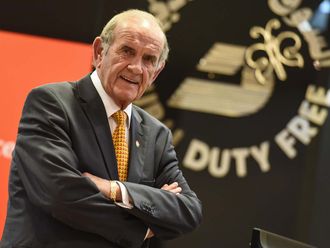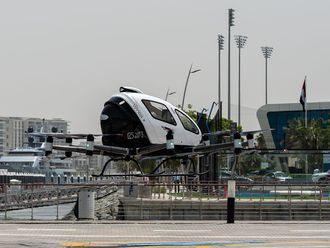
Dubai: The Middle East will require 2,520 aircraft with an investment of $450 billion (Dh1.65 trillion) in the next 20 years to meet growing demand, according to US plane maker Boeing.
This is significantly higher than the projections by Airbus, which said the Middle East will require 1,882 aircraft in the next 20 years, with a value of $336 billion.
"The investment of $450 billion to acquire 2,520 jets in 20 years is a very conservative evaluation of the Middle East carriers that are continuously looking at increasing their destinations and expanding their global and regional market share," said an aerospace and defence analyst at Frost & Sullivan.
"This long-term aircraft acquisition plan may also be seen as a replacement for the older aircraft by the Middle East carriers."
Hub cities
Airbus projections are based on the fact that 4.9 billion people worldwide will become part of the growing middle class by 2030 of which 66 per cent will be in the Asia-Pacific region.
In 2010, 105 million of the 1.84 billion middle class population lived in the Middle East. By 2020, the world's middle class population will rise to 3.25 billion of which 165 million will be in the Middle East.
Airbus identified 39 mega airline hub cities in the world in 2010. By 2030, the number will rise to 87.
Today, about 50 per cent of the world's population lives in cities, by 2030, this will be nearly 60 per cent — and that will have a direct impact on air traffic demand.
By 2030, the world's top 20 large hub cities will be located in the Asia-Pacific and the Middle East regions, with Dubai becoming the world's largest hub city, replacing the biggest hubs.
Civil unrest
There are 1,040 aircraft currently in service in the Middle East and North Africa, Boeing said.
The civil unrest in Egypt, Bahrain, Libya, Syria, Yemen, and Tunisia has dampened the outlook for 2011, Boeing said. While the impact on global traffic has been relatively minor, some of the region's most important destinations have been affected.
"Despite the turmoil, the region's economy is forecast to grow 6 per cent in 2011, outpacing the world average. The six nations of the Gulf Cooperation Council are forecast to average 7.8 per cent growth as energy production expands to cover the shortfall from other oil-producing countries," Boeing's latest version of the Current Market Outlook said.
Airbus said Middle East passenger traffic will grow 7.4 per cent year-on-year for the next 20 years and the region's revenue passenger kilometre (RPKs) will represent 11 per cent of the global RPKs by 2030.
According to Frost & Sullivan, the sovereign debt crisis in the Eurozone may affect business travel between Europe and the Middle East.
"This can be a challenge for the Gulf carriers as Europe serves one of the largest markets and holds a significant revenue share for them. This may also force the Gulf carriers to cut frequencies and lower their fares on European routes to remain profitable," said an analyst at Frost & Sullivan.
The growth is expected to be driven by the three major Gulf airlines — Emirates, Etihad Airways and Qatar Airways — as well as the new budget carriers Air Arabia and FlyDubai.
Challenges
"Emirates remains focused on its long-term strategy despite global instability, ever-climbing fuel prices and fluctuating exchange rates," Shaikh Ahmad bin Saeed Al Maktoum, President of Dubai Civil Aviation and Chairman and Chief Executive of Emirates airline and Group, said in a statement.
"The global challenges of the past six months have again put Emirates to the test, and once again we have risen to the challenge and continue to maintain our high standards of product and services," he said.
Also, the bilateral air agreements between South Asia and the Middle East may result in increasing competition and price wars among these carriers.
"The major Gulf carriers need to strengthen their position in order to keep hold of the market. Expanding services to regional routes with greater regional competition in the Middle East is also a challenge for Gulf carriers," an aerospace and defence analyst at Frost & Sullivan told Gulf News.
Emerging markets
"Forty years ago, 76 per cent of the world's traffic flew from, to or between North America, Western Europe and Japan. Today, as more of the world has embraced flights and been able to take advantage of its benefits, this share has dramatically reversed," Airbus said.
"Some 57 per cent is now centred in other parts of the world. This is not to say that these original regions will not also grow; they will, almost doubling their traffic over our forecast period."
By 2030, about 70 per cent of the global passenger traffic will come from the emerging markets.
Capacity at the three carriers, Emirates, Qatar Airways, and Etihad, collectively has grown 23 per cent annually over the past 10 years.
"Approximately half the 885 planes on order in the Middle East, including 72 per cent of the widebodies, will go to these carriers," Boeing said.
Their growth is likely to continue as the large backlog of new, efficient planes that the three carriers have on order will provide a competitive advantage over European and Asian rivals.
"This is the one region of the world that has some of the fewest ageing planes to replace, and many of the carriers like Emirates, Qatar Airways and Etihad Airways have only really exploded onto the scene with big and regular orders as they have seen their operations grow during this last decade," Saj Ahmad, a UK-based aviation analyst, told Gulf News.
It is equally worth pointing out that Boeing's Current Market Outlook for the Middle East, like all its previous forecasts, has been a little on the conservative side, so the 2,500-plus jets they envision over the next two decades could be several hundred units too few if airlines start placing additional orders that replace some of the inventory in service today, he argued.
New destinations
"Now that the 787-8 has entered service, it is likely that Boeing will push ahead with the stretched 787-10X, a model that Emirates has been very receptive towards, so there's always the distinct possibility that the big Arab airlines will continue to order new jets — not just for the sake of it, but because the number of new destinations they can offer are as a direct result of the additional performance capabilities of new-generation planes," Ahmad said.
While air transport markets in the rest of the world shrank during the global economic downturn of 2009, international air travel continued to grow for Middle East carriers, demonstrating the region's prominence in global air travel. International traffic continued to grow during 2010, rising 17.8 per cent for Middle Eastern carriers — far exceeding the world average of 8.2 per cent growth.
Sixth freedom
The market strategy of the "Gulf 3" airlines is based on the so-called sixth freedom, which allows an operator in one country to carry passengers or cargo from a second country to a third country via a scheduled stop in the operator's home country.
Sixth freedom privileges have enabled Emirates, Qatar Airways and Etihad to take advantage of their central location to expand their share of traffic between Europe and Asia.
Global fleet will double by 2030
Dubai: Worldwide economic activity is the most powerful driver of growth in commercial air transport and the resulting demand for planes, Boeing says.
The global gross domestic product (GDP) is projected to grow at an average of 3.3 per cent per year for the next 20 years. Reflecting this economic growth, worldwide passenger traffic will average 5.1 per cent growth and cargo traffic will average 5.6 per cent growth over the forecast period.
"To meet this increased demand for air transportation, the number of planes in the worldwide fleet will grow at an annual rate of 3.6 per cent, nearly doubling from around 19,400 planes today to more than 39,500 planes in 2030," Boeing said in its Current Market Projections.
"Plane deliveries, for fleet growth and replacement of ageing planes, will total 33,500 over the next 20 years, with a value of $4.0 trillion."
On the other hand, Airbus' Global Market Forecast, said that the world's passenger aircraft fleet (above 100 seats) will grow from 15,000 at the beginning of 2011 to just over 31,000 by 2030.
Eco-efficient
"At the same time, some 10,500 aircraft from the existing fleet will be replaced by more eco-efficient models. Of these, 3,400 will be recycled back into passenger service, where they too will replace older-generation less eco-efficient aircraft with another airline," Airbus said.
It is also forecast that 2,200 aircraft will be converted to freighters with the remaining 8,300 permanently retired or withdrawn from service. Thus, Airbus projects aircraft demand globally will shoot up to 26,921 by 2030, worth $3.2 trillion. This is significantly lower than Boeing's 31,000 aircraft, worth $4 trillion.
The difference in the market projections lies in their view on how air travel patterns are likely to change.
Airbus focuses more on the hub-and-spoke model, suggesting that air travel will be routed through mega hub cities where airlines will be forced to operate large double-decker aircraft such as the Airbus A380s due to slot restrictions at hub airports.
Point-to-point
On the other hand, Boeing's projections are based on the assumption that air travel will be dominated by point-to-point travel - meaning that travellers will choose mostly city-to-city short and medium haul connections to reach destinations that will require more mid-size jets such as Boeing Dreamliner 787s.
According to Frost & Sullivan, the global aviation industry is moving from hub-and-spoke model to point-to-point travel as it provides access to multiple destinations.
"Hub-and-spoke model is mainly used by the full service carriers as it provides efficient transportation and simplifies the network of routes. But it is the least preferred model among passengers due to the longer journey," said an Aerospace and Defence Analyst at Frost & Sullivan.
Needless to say, both manufacturers have made their projections to promote and justify their new models of aircraft. However, most growing large airlines adopt a mixed-fleet policy where both Airbus and Boeing have their fair share of the pie.












